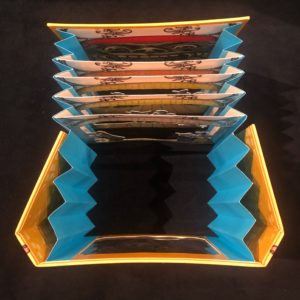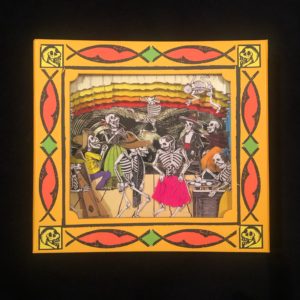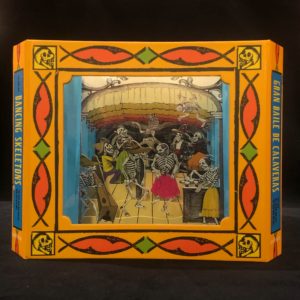
Gran Baile de Calaveras, un Libro Túnel
The Day of the Dead is celebrated in the publication, Gran Baile de Calaveras, un Libro Túnel [The Dancing Skeletons Tunnel Book], by Joan Sommers, a work in the Cooper Hewitt Smithsonian Design Library. The book is a concertina-like folding form, composed of five separate scenes, each on a different panel. When viewed through the window of the book’s front cover, the panels are compiled together to create a cohesive narrative scene. Skeletons are dressed in vivid hues reminiscent of the colors used in Day of the Dead celebrations across Mexico. Two skeletons are positioned in the center, dancing. A musician and cook are arranged in the foreground and two couples are in the background. The lively scene conveys the excitement of spirited music and dance.

Gran Baile de Calaveras, un Libro Túnel
The Day of the Dead honors the memory of loved ones who have passed, through a reunion between the living and the dead. Between October 31st and November 2nd it is believed that spirits arrive at the homes of their families. Today, many people prepare an altar in their home to welcome the returning souls. The altar is often decorated with candles, photographs, sugar skulls, and food. The festivities continue as family members go to clean grave sites and leave small mementos such as candles or flowers to honor their loved ones.
The iconic imagery of skeletons associated with The Day of the Dead was devised by Mexican print maker and cartoonist, José Guadalupe Posada. Posada began working in the studio of José Trinidad Pedroza in 1870, and later developed imagery of the calavera, or skeleton, for publications available during Day of the Dead celebrations. The satirical skeletons impersonate the everyday activities of the living. However, Posada implies that death eliminates social inequality since everyone meets the same fate. Posada gained notoriety for his work, but died penniless in 1913. Posada created over 20,000 engravings throughout his career, and has been recognized for his influential work in Mexican Graphic Art.
Erica M. Schaumberg is a graduate student in the History of Design and Curatorial Studies program offered jointly by Cooper Hewitt and Parsons School of Design. She is also a fellow at the Cooper Hewitt Smithsonian Design Library.
